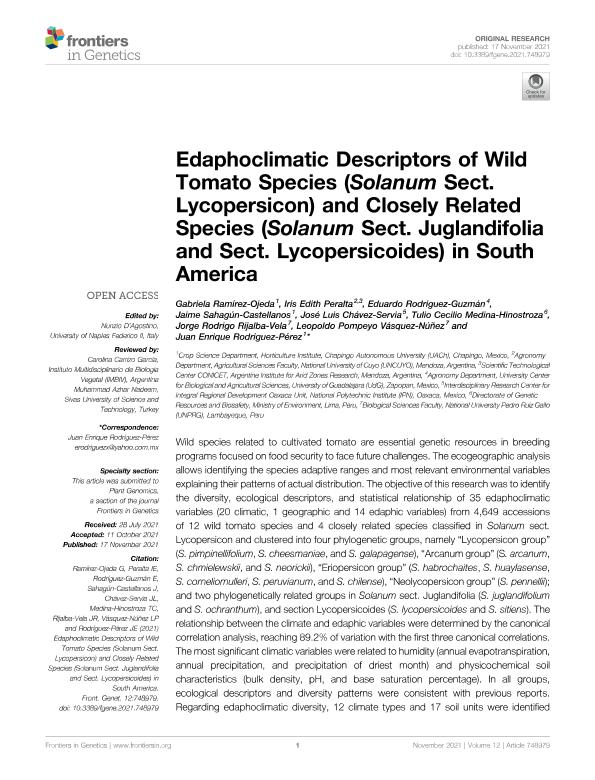Mostrar el registro sencillo del ítem
dc.contributor.author
Ramírez Ojeda, Gabriela
dc.contributor.author
Peralta, Iris Edith

dc.contributor.author
Rodríguez Guzmán, Eduardo
dc.contributor.author
Sahagún Castellanos, Jaime
dc.contributor.author
Chávez Servia, José Luis
dc.contributor.author
Medina Hinostroza, Tulio Cecilio
dc.contributor.author
Rijalba Vela, Jorge Rodrigo
dc.contributor.author
Vásquez Núñez, Leopoldo Pompeyo
dc.contributor.author
Rodríguez Pérez, Juan Enrique
dc.date.available
2022-09-01T19:52:07Z
dc.date.issued
2021-11
dc.identifier.citation
Ramírez Ojeda, Gabriela; Peralta, Iris Edith; Rodríguez Guzmán, Eduardo; Sahagún Castellanos, Jaime; Chávez Servia, José Luis; et al.; Edaphoclimatic descriptors of wild tomato species (Solanum Sect. Lycopersicon) and closely related species (Solanum Sect. Juglandifolia and Sect. Lycopersicoides) in South America; Frontiers Media; Frontiers in Genetics; 12; 11-2021; 1-16
dc.identifier.issn
1664-8021
dc.identifier.uri
http://hdl.handle.net/11336/167266
dc.description.abstract
Wild species related to cultivated tomato are essential genetic resources in breeding programs focused on food security to face future challenges. The ecogeographic analysis allows identifying the species adaptive ranges and most relevant environmental variables explaining their patterns of actual distribution. The objective of this research was to identify the diversity, ecological descriptors, and statistical relationship of 35 edaphoclimatic variables (20 climatic, 1 geographic and 14 edaphic variables) from 4,649 accessions of 12 wild tomato species and 4 closely related species classified in Solanum sect. Lycopersicon and clustered into four phylogenetic groups, namely “Lycopersicon group” (S. pimpinellifolium, S. cheesmaniae, and S. galapagense), “Arcanum group” (S. arcanum, S. chmielewskii, and S. neorickii), “Eriopersicon group” (S. habrochaites, S. huaylasense, S. corneliomulleri, S. peruvianum, and S. chilense), “Neolycopersicon group” (S. pennellii); and two phylogenetically related groups in Solanum sect. Juglandifolia (S. juglandifolium and S. ochranthum), and section Lycopersicoides (S. lycopersicoides and S. sitiens). The relationship between the climate and edaphic variables were determined by the canonical correlation analysis, reaching 89.2% of variation with the first three canonical correlations. The most significant climatic variables were related to humidity (annual evapotranspiration, annual precipitation, and precipitation of driest month) and physicochemical soil characteristics (bulk density, pH, and base saturation percentage). In all groups, ecological descriptors and diversity patterns were consistent with previous reports. Regarding edaphoclimatic diversity, 12 climate types and 17 soil units were identified among all species. This approach has promissory applications for biodiversity conservation and uses valuable genetic resources related to a leading crop.
dc.format
application/pdf
dc.language.iso
eng
dc.publisher
Frontiers Media

dc.rights
info:eu-repo/semantics/openAccess
dc.rights.uri
https://creativecommons.org/licenses/by/2.5/ar/
dc.subject
CANONICAL CORRELATION ANALYSIS
dc.subject
ECOLOGICAL DESCRIPTORS
dc.subject
EDAPHOCLIMATIC DIVERSITY
dc.subject
GENETIC RESOURCES
dc.subject
WILD TOMATOES
dc.subject.classification
Ciencias de las Plantas, Botánica

dc.subject.classification
Ciencias Biológicas

dc.subject.classification
CIENCIAS NATURALES Y EXACTAS

dc.title
Edaphoclimatic descriptors of wild tomato species (Solanum Sect. Lycopersicon) and closely related species (Solanum Sect. Juglandifolia and Sect. Lycopersicoides) in South America
dc.type
info:eu-repo/semantics/article
dc.type
info:ar-repo/semantics/artículo
dc.type
info:eu-repo/semantics/publishedVersion
dc.date.updated
2022-09-01T15:25:22Z
dc.journal.volume
12
dc.journal.pagination
1-16
dc.journal.pais
Suiza

dc.journal.ciudad
Lausana
dc.description.fil
Fil: Ramírez Ojeda, Gabriela. Universidad Autónoma Chapingo; México
dc.description.fil
Fil: Peralta, Iris Edith. Consejo Nacional de Investigaciones Científicas y Técnicas. Centro Científico Tecnológico Conicet - Mendoza. Instituto Argentino de Investigaciones de las Zonas Áridas. Provincia de Mendoza. Instituto Argentino de Investigaciones de las Zonas Áridas. Universidad Nacional de Cuyo. Instituto Argentino de Investigaciones de las Zonas Áridas; Argentina
dc.description.fil
Fil: Rodríguez Guzmán, Eduardo. Universidad de Guadalajara; México
dc.description.fil
Fil: Sahagún Castellanos, Jaime. Universidad Autónoma de Chapingo; México
dc.description.fil
Fil: Chávez Servia, José Luis. Instituto Nacional Politécnico; México
dc.description.fil
Fil: Medina Hinostroza, Tulio Cecilio. Gobierno del Perú. Ministerio del Ambiente; Perú
dc.description.fil
Fil: Rijalba Vela, Jorge Rodrigo. Universidad Pedro Ruiz Gallo; Perú
dc.description.fil
Fil: Vásquez Núñez, Leopoldo Pompeyo. Univeridad Pedro Ruiz Gallo; Perú
dc.description.fil
Fil: Rodríguez Pérez, Juan Enrique. Universidad Autónoma de Chapingo; México
dc.journal.title
Frontiers in Genetics
dc.relation.alternativeid
info:eu-repo/semantics/altIdentifier/url/https://www.frontiersin.org/articles/10.3389/fgene.2021.748979/full
dc.relation.alternativeid
info:eu-repo/semantics/altIdentifier/doi/http://dx.doi.org/10.3389/fgene.2021.748979
Archivos asociados
